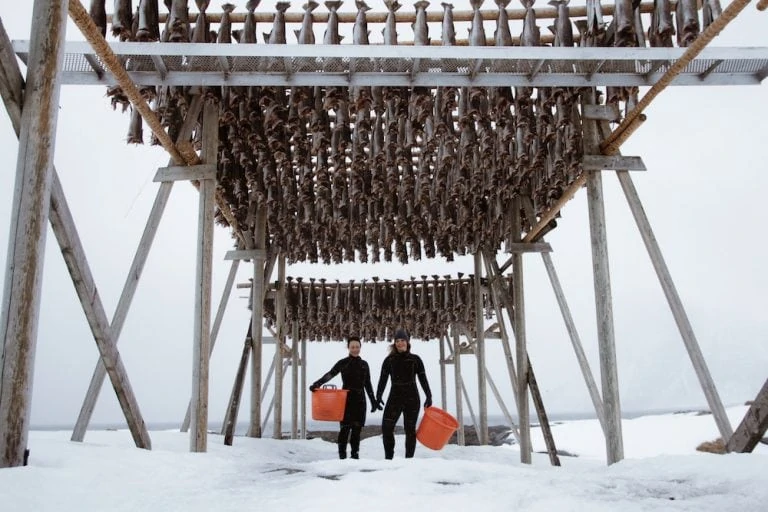Lofoten Traditions

Skrei and Seaweed – do Lofoten traditions live on?
Life in Lofoten is inextricably linked to the ocean. From as far back as the late Stone Age, humans have been drawn to these islands to live and work off the sea, with evidence of activity from the Iron Age and the Viking Age, right the way through to the present day.
For the past millennium, people have followed the annual migration of Skrei, or Arctic Cod, south from the Barents Sea. Every year in early Spring, the Skrei fishery bursts into life, and the islands heave with cod that hang from drying racks dotted all over the islands. The cod, dried naturally by the sun and the wind, is transformed into tørrfisk – stockfish – that is in demand all over the world, forming part of a traditional diet in Portugal, Italy and Nigeria.
Lofoten stockfish has been awarded Protected Geographical Indication (PGI) status, which means that similar to champagne, Parma ham and feta cheese, the only truly authentic stockfish comes from this area alone. The Skrei fishery and resulting stockfish industry is an ancient Lofoten tradition that is still thriving today, and the presence of our island ancestors is tangible through these practices.
It’s not just through the Skrei fishery that we are connected with our history in Lofoten. We know from several sources that the Vikings enjoyed eating seaweed as part of a healthy diet, and as a beer snack! Dried dulse has a nutty, bacon-like flavour that is said to go extremely well with beer, or mead as the Vikings would have been drinking at the time.
In Old Norse, dulse is referred to as søl. It appears in many sources, in particular the famous saga by Egill Skallagrímmson. In one passage, Egill, stricken with grief over the loss of his son, decides to starve himself to death. Knowing that her father was a stubborn man, his clever daughter Thorgerd tricked him by feeding him dulse, promising him that it would bring about a quick and painless end. After eating the salty dulse, Egill was further tricked into drinking a glass of milk. The rejuvenating power of the dulse and the milk is said to have renewed Egill’s appetite for life, and he went on to become one of the most renowned poets of the Viking age.

Egill Skallagrímmson was Icelandic, but eating seaweed was just as popular across the water in Norway. It’s said that the sea-faring Norwegian Vikings would take dried seaweed on long voyages, perhaps because they were aware that it warded off illness as well as hunger pangs. Mouritsen et al writes:
“Norwegians… ate fresh dulse baked in bread and dried and salted dulse as a sort of snack. For the preparation of a meal, the seaweed was mixed with butter or lard and served with dried fresh or cooked potatoes and turnips. Another way of preparing dulse was to cook it with milk or put it in porridge. Finally, dulse has also been added to bread dough in order to make the flour stretch farther. The Norwegian Vikings probably brought dried seaweeds with them as provisions for their long expeditions maybe having realized [sic] that it protected the seafarers against scurvy.”
The Lofoten tradition of eating seaweed was lost to history for a time, and the use of this amazing vegetable was limited to fertiliser and animal feed. But the sight of the Skrei fishery, just as relevant to life in Lofoten as ever, gives rise to the argument that a seaweed renaissance is long overdue. With its roots firmly in Norwegian history, there is absolutely a place for seaweed in the nordic kitchen, and we are proud to be part of the movement to revive this Lofoten tradition.